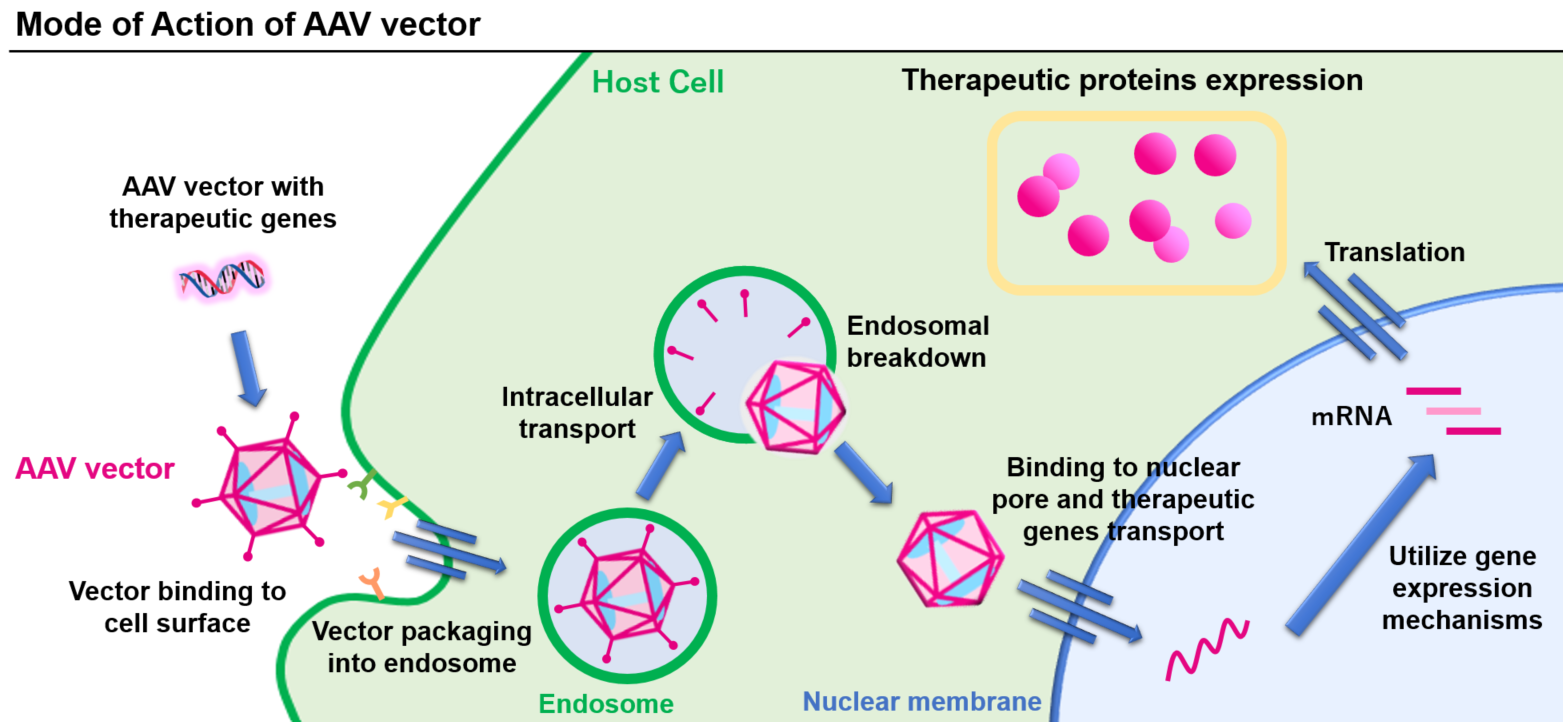In gene therapy, viral vectors, in which pathogenicity is artificially excluded, play an important role in delivering therapeutic genes to tissues and cells. As adeno-associated virus (AAV) vectors are relatively safe due to their non-pathogenic nature and exhibit various tissue tropisms, they have been actively researched and developed as gene therapy vectors by pharmaceutical companies and start-up companies in recent years. Following its approval in Europe in 2012 as a treatment of lipoprotein lipase deficiency, AAV gene therapy products have also been approved in recent years for spinal muscular atrophy and hereditary retinal dystrophy. In gene therapy using AAV vectors, it is crucial for the therapeutic genes to be delivered to the target tissues or cells to ensure both efficacy and safety.
Takara Bio is actively developing AAV vectors for gene therapy that exhibit high tissue specificity for specific tissues through collaborations with universities and public research institutions. As part of our research efforts, we have successfully developed AAV vectors with enhanced targeting capabilities for brain and inner ear tissues. We are actively advancing the development of gene therapies using these vectors, and have also initiated CDMO services for AAV vectors to support the translation of gene therapy into practical applications in society.
- Upon administered, AAV vectors carrying therapeutic genes are internalized by cells.
- The genes carried by the AAV vectors are transported into the nucleus of the host cell, where they utilize the host cell's gene expression machinery for transcription and translation, resulting in the expression of therapeutic proteins.
- The expressed proteins have the potential to address genetic deficiencies or abnormalities responsible for the disease, thereby slowing down disease progression and improving symptoms.

CereAAV™
In brain-targeted gene therapy, AAV vectors injected intravenously tend to accumulate in organs other than brain, such as liver, and therefore it has been suggested that high doses may cause adverse reactions. To overcome this problem, highly brain-directed AAV vectors are needed for brain-targeted gene therapy. We succeeded in developing CereAAVTM, a novel AAV vector for gene therapy, which was derived from AAV2 through genetic engineering and unique screening techniques and has a highly brain-targeted tropism. In mice, CereAAVTM showed gene transduction to the brain by intravenous injection more efficiently than AAV9, the conventional gene used for gene therapy. In cynomolgus monkeys, a primate more closely related to humans, CereAAVTM showed more efficient gene transduction than AAV2 and AAV9 in several brain regions.
A collaborative research with Tokyo Metropolitan Institute of Medical Science, revealed that CereAAVTM demonstrated more efficient gene transduction by intravitreal injection into mouse retinal cells compared to AAV2. Currently, AAV vector based gene therapy approved for ocular disease requires highly invasive subretinal injection. Therefore, there is a need for AAV vectors that can efficiently transduce genes into retinal cells by simple intravitreal injection. We have been developing CereAAVTM for clinical use of gene therapy for brain and ocular diseases.
We provide contract manufacturing services for various viral vectors, including AAV vectors.
We also provide CDMO services for CereAAVTM series including the modified vectors.
[For the details of CDMO services]
https://www.takarabio.com/services-and-support/gene-and-cell-therapy-manufacturing/services
SonuAAV™
Recently, AAV gene therapy has also been developed for hereditary hearing loss. However, the gene transduction efficiency of conventional AAV vectors to the inner ear is not sufficient to demonstrate therapeutic efficacy. We have also developed a novel AAV vector, SonuAAVTM, which exhibits high gene transfer efficiency into mouse inner ear tissues, in collaboration with Juntendo University. In this study, we found that local injection of SonuAAVTM into mouse inner ear efficiently delivers genes to the target tissues for gene therapy. Moreover, we also demonstrated that SonuAAVTM expressing GJB2 gene can improve the hearing in adult Gjb2-deficient mice 6 week after local injection. We have also developed SonuAAVTM-based gene therapy for hereditary hearing loss.
|
Conference |
Title |
|
BioJapan 2024 October 9 ‒ 11, 2024 Yokohama, Japan |
Development of Gene Therapy for Hereditary Hearing Loss Using Adeno-Associated Virus (AAV) |
|
The 30th Annual Meeting of Japan Society of Gene and Cell Therapy July 16 - 18, 2024 Yokohama, Japan |
Improvement of gene delivery efficiency into the mouse brain through amino acid substitution of CereAAV |
|
A Novel AAV2 Mutant SonuAAV Expressing mGjb2 can Improve Hearing in Adult Gjb2-deficient Mice by Cochlear Perilymph Administration |
|
|
2024 ASGCT (American Society of Gene and Cell Therapy) Annual Meeting Baltimore, U.S.A |
A Novel AAV2 Mutant SonuAAVTM Expressing mGjb2 Can Improve Hearing in Adult Gjb2-Deficient Mice by Cochlear Perilymph Administration |
|
Characterization of Brain Targeting CereAAVTM Gene Transduction in Cynomolgus Macaque and Further Improvement of Gene Delivery Capability by Amino Acid Substitutions |
|
|
The 14th International Symposium of Gunma University Initiative for Advanced Research (GIAR) February 14, 2024 Gunma, Japan |
Characterization of Brain Targeting CereAAVTM Gene Transduction and Further Improvement of Gene delivery capability by Amino Acid Substitutions. |
|
BioJapan 2023 October 11 – 13, 2023 Yokohama, Japan |
The front line of gene therapy development for adeno-associated virus (AAV) vectors with tissue tropism (retina, inner ear) |
|
The 29th Annual Meeting of Japan Society of Gene and Cell Therapy September 11 -13, 2023 Osaka, Japan |
Analysis of brain-directed mechanism of CereAAVTM |
